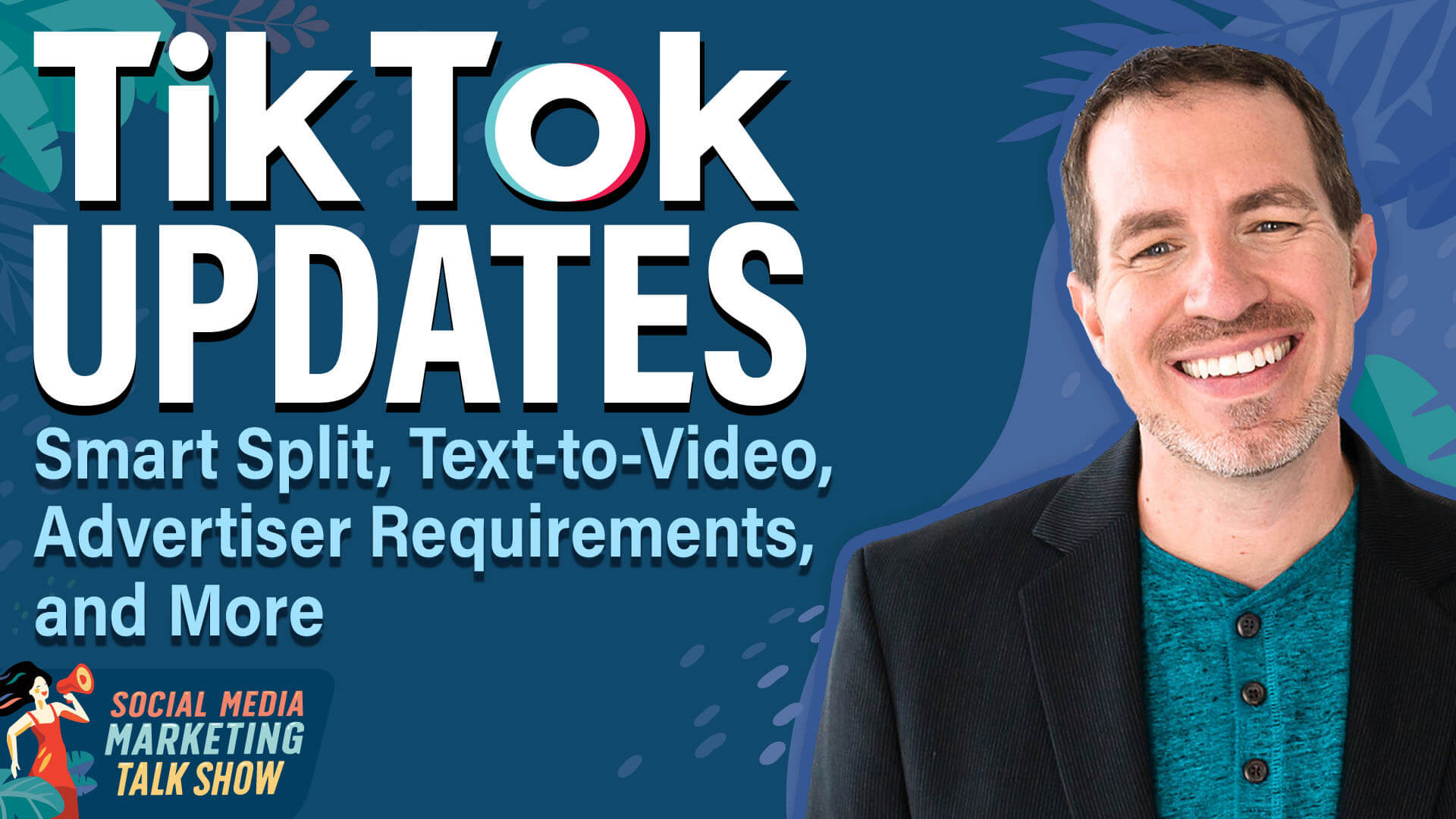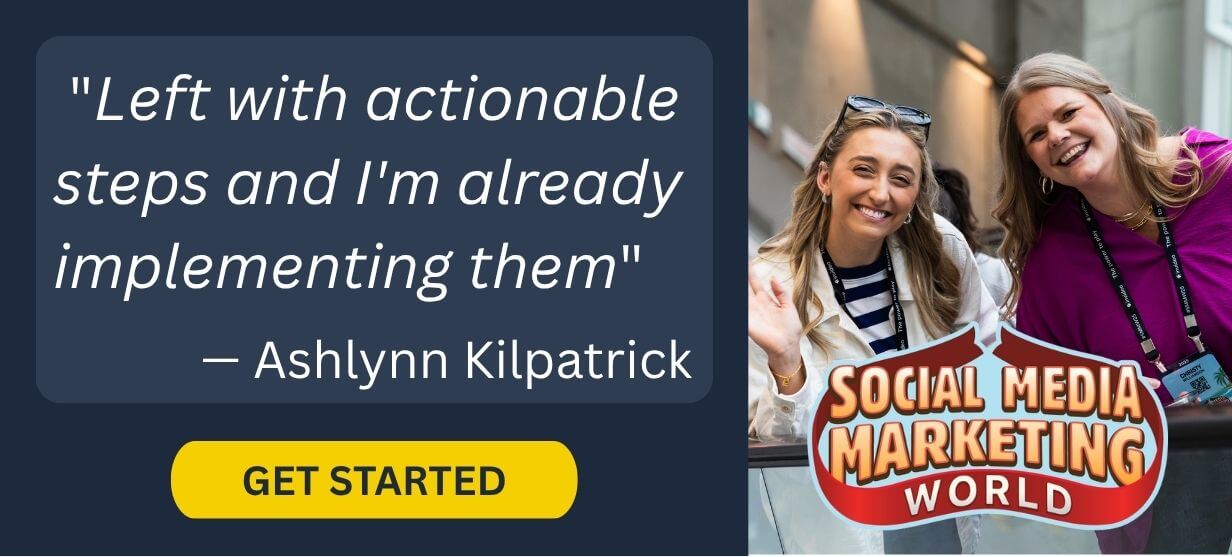Today's Guide to the Marketing Jungle from Social Media Examiner...
presented by 
Here's a recap of the most important insights, trends, and updates you need to know about today, Alluser! Catch up in minutes and go into the rest of the week prepared.
In today's edition:
-
How long should your Instagram Reels be?
-
TikTok updates for marketers
-
Prep your marketing for AI's transformation of human behavior
-
🗞️ Industry news from ChatGPT, LinkedIn, YouTube, and more

Length Guidelines for 3 Instagram Reels
Is your Instagram strategy riding the algorithm—or falling flat?
While Instagram allows up to 3-minute Reels, few creators see real reach beyond the 90-second mark. That's not a fluke; it's a signal. In a scroll-happy feed, your audience is deciding in seconds whether to stick around or swipe on.
So, how short is too short—and how long is long enough to keep viewers hooked and boost your reach?
Knowing the ideal video lengths is key to making those efforts actually pay off. And if video is already part of your workflow (or high on your learning list), tweaking your timing could be the simplest move with the biggest return.
Lucas O'Keefe shares how to time three types of Reels used in your marketing. Read more here.


On this week's Social Media Marketing Talk Show, host Jerry Potter breaks down the latest TikTok news and what it means for marketers like you.
TikTok Bulletin Boards
Instagram has broadcast channels and now TikTok has Bulletin Boards.
Potter explains that Bulletin Boards are a new in-app broadcast channel for creators and businesses to share updates and exclusive content with their followers. He emphasizes the importance of early adoption: "We all know new features get really high priorities of views and visibility and all of that right at the beginning."
"The best part about this feature is that it has push notifications included," Potter notes. After somebody chooses to follow your board, they'll get notifications in their inbox whenever you post. Followers who opt-in can react with emojis, but there are no reply options or chat features, so the maintenance bar is low.
When you create a Bulletin Board, give it a name related to the type of content you're going to share there. For businesses, Potter suggests names like "The Insiders Club" or "The VIP Club" to create an exclusive feel. You'll also see a toggle to control whether the Bulletin Board shows up on your profile or not. Potter notes that from a marketer's perspective, you'll want to show it on your profile.
Next, post a couple of videos to let your audience know about your Bulletin Board.
"The good news is this is rolling out globally," Potter says. The bad news is that the feature is currently only available for accounts with at least fifty thousand followers globally.
More Features, Tools, Changes, and Updates Discussed Include:
-
Managing Your Bulletin Board
-
Text-to-Video and Image-to-Video Features
-
AI Content Creation Tools
-
Critical Advertiser Update
Watch it on YouTube

AI is Changing Human Behavior: How to Prepare
The rise of AI represents more than just another technological advancement—it's fundamentally rewiring how people think, make decisions, and interact with the world around them. For marketers and business professionals who need to understand their customers better than anyone else, grasping these behavioral shifts has become essential for survival and success.
One of the most significant behavioral shifts Schaefer identifies is the growing trust people place in AI for major life decisions. As AI is becoming a integral part of the decision-making process, marketers need to market to the AI rather than directly to the end user.
This shift has profound implications for marketing strategy. Unlike Google, which provides a list of suggestions or links for users to explore, AI often provides definitive recommendations. Additionally, when ChatGPT announced it was embedding e-commerce directly into its answers, starting with partnerships with Shopify and eBay, it signaled a future where AI doesn't just influence decisions but facilitates transactions directly.
The challenge for businesses becomes clear: How do you ensure your brand appears in AI recommendations when competing against potentially hundreds of thousands of other options? Schaefer suggests that rather than trying to optimize for AI recommendations alone, businesses should focus on building strong brand preferences that can serve as overrides to AI suggestions.
To prepare your marketing for these AI-driven behavior changes, Schaefer offers several concrete steps.
Use a Two-Audience Strategy for Content Creation
One of Schaefer's most provocative suggestions is that businesses may need to develop separate content strategies for human and AI audiences. He's adamant about not compromising his human audience—his blog readers, podcast listeners, and book readers. His content for humans will always be worth their time, make them think, and provide value through engaging, interesting, and sometimes entertaining delivery.
However, AI has different needs. As Schaefer explains, "AI doesn't care. AI doesn't want to be entertained. It never gets bored. It never gets tired. It just wants the data. It just wants the details. Endless, endless, endless details."
This realization led Schaefer to create extensive FAQ sections on his website—not primarily for human visitors, who can easily understand what he does from his home page's intuitive design, but for AI. He spent considerable time thinking through every question someone might ask about hiring him as a speaker, attending his retreats, or buying his books, then created long, detailed content answering these questions.
"AI wants details. It wants to know in extreme detail what you do," Schaefer emphasizes. This FAQ content is essentially bot-oriented rather than human-oriented, designed to feed AI systems the comprehensive information they need to make recommendations.
Another crucial part of this two-audience content strategy involves making content more accessible to AI. Currently, AI struggles with certain content formats. As Schaefer learned from OpenAI's Sam Altman, AI has difficulty with facial expressions, sarcasm, and tone, making it challenging to process video and podcast content accurately. Additionally, the computational expense of processing video or podcasts is ten times that of processing text.
This limitation has significant implications for content creators and makes quality transcripts for audio and video content important. The goal isn't just to have any transcript but to create valuable transcripts that AI can process effectively. As Schaefer explains, "That's valuable content. And I want to get credit for that in AI."
Schaefer admits he's been lazy with his transcripts but is now redoubling efforts to create better, informative, detailed transcripts for all the video and podcast content on his website. He's even considering paying someone to go back and create valuable transcripts for at least a couple hundred previous podcast episodes.
Other topics discussed include:
-
Why Understanding AI's Impact on Human Behavior Matters for Marketers
-
How People Are Making Decisions with AI
-
How to Prepare Your Business for AI-Driven Behavior Changes
-
Letting AI Access Your Content
-
Leveraging Online and Offline Marketing Tactics
Today's advice provided with insights from Mark Schaefer, a featured guest on the AI Explored podcast.
Watch the full interview on YouTube
Google Adds Conversational AI and Agentic Features to Holiday Shopping: Google has launched several AI-powered updates to streamline holiday shopping across Search and the Gemini app. Users can now describe their gift needs in everyday language through AI Mode and receive rich, tailored responses with visuals, reviews, and real-time product data. The Gemini app also offers in-chat shopping suggestions and comparisons. New "agentic" features allow Google to call nearby stores to confirm product availability and prices, while a smart checkout tool can monitor item prices and complete purchases when they drop within a user's budget. These upgrades aim to simplify holiday shopping while saving users time and money. Google
GPT‑5.1 Launches with Smarter, More Personalized ChatGPT Experience: OpenAI has introduced GPT‑5.1, the latest version of its flagship model, with significant upgrades to reasoning, communication style, and user customization. GPT‑5.1 Instant now feels more conversational and intuitive, while GPT‑5.1 Thinking adapts its response time based on task complexity for better accuracy and clarity. Users can personalize ChatGPT's tone—like Friendly or Quirky—and adjust response characteristics such as length or emoji use. Rolling out first to paid users, GPT‑5.1 enhances both usability and intelligence. OpenAI
LinkedIn Introduces AI‑Driven People Search to Premium U.S. Users: LinkedIn has unveiled a new AI‑powered people search tool that allows users to find professionals by writing descriptive queries—such as "Spanish‑speaking school counselors in Austin focused on learning differences"—rather than relying solely on specific titles, keywords or company names. The platform says this will make it faster and easier for members to identify colleagues, mentors, collaborators or subject‑matter experts across their network or extended connections. For now, the feature is available to Premium subscribers in the U.S., with a broader rollout planned in the near future. LinkedIn
LinkedIn Launches AI-Powered People Search for Premium Users: LinkedIn has unveiled a new AI-driven people search tool designed to help users find relevant professionals more easily using natural language. Rather than requiring specific filters or titles, Premium subscribers in the U.S. can now simply describe the type of person they're looking for—such as "an expert in digital marketing"—and receive smarter, more contextual results. The tool is powered by LinkedIn's AI and enriched data, with broader rollout expected soon. LinkedIn
Google Unveils Gemini-Powered Ads and Analytics Advisors: Google is introducing Ads Advisor and Analytics Advisor, AI agents powered by Gemini, to help advertisers unlock performance insights and streamline decision-making. Ads Advisor offers real-time campaign support, from asset creation to policy troubleshooting, while Analytics Advisor surfaces data-driven insights and growth recommendations via natural language queries. Launching globally in December for English-language accounts, these tools are set to transform how advertisers and marketers work in Google Ads and Google Analytics. Google
Google App Launches New Images Tab for Personalized Visual Discovery: Google has introduced a dedicated Images tab in its mobile app, providing a new way for users to discover and organize visual content tailored to their interests. The feature serves up a daily selection of images related to topics like fashion, travel, and lifestyle, making it easier to spark inspiration and save creative ideas. Users can browse, search, and save images to personal collections directly in the app. The update is rolling out in the U.S. for Android and iOS users over the next few weeks. Google
X Debuts Chat, A Secure, Unified Messaging Upgrade: X (formerly Twitter) is replacing its legacy DMs with a new encrypted messaging system called Chat. The rollout begins on iOS and Web, with Android coming soon. Chat supports voice memos, file sharing, disappearing messages, and even blocks screenshots—with alerts if attempts are made. With no ads or tracking, X positions Chat as a privacy-first alternative. Voice memos will return shortly. X
YouTube Tests Comment Summaries in Studio Mobile: YouTube is testing a new feature that offers creators AI-generated summaries of comments in the YouTube Studio mobile app. This tool is designed to help creators more efficiently understand audience feedback by summarizing key themes and sentiments in video comments. Early testers can access the summaries by tapping Get summary on a video's Comments page, with feedback options available to improve the feature. A wider rollout is expected soon. YouTube
What Did You Think of Today's Newsletter?
Michael Stelzner, Founder and CEO
P.S. Add
michael@socialmediaexaminer.com into your contacts list. Use Gmail?
Go here to add us as a contact.
We publish updates with links for our new posts and content from partners. Your information: Email:
tukangpostemel@gmail.com Opted in on: 2021-09-06 17:03:43 UTC.








